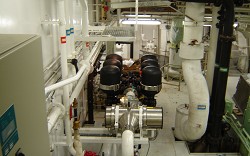
Ballast Water Treatment Technology R&D
The Development of Treatment Technologies
Ballast Water Treatment Technology R&D is still in its nascent stages - no technologies have been approved under federal regulations or the IMO convention (see the Treatment Technology Approval Process page), although many technologies are under development. Many companies are hesitant to develop and implement full-scale treatment technologies that meet a certain standard (such as organisms/mL) until actual standards have been approved by the USCG, which is expected to release standards soon.
The treatment of ballast water is seen as a preferred alternative to ballast exchange for several reasons, including increased efficacy and safety. Several types and methods of treatment technologies are under development including:
- Mechanical treatment - methods such as filtration and separation
- Physical treatment - methods such as sterilization by ozone, UV light, or electric currents
- Chemical treatment - methods such as adding biocides to ballast water to kill organisms
- Various combinations of the above
Treatment technologies must be safe, environmentally acceptable, cost-effective, and successful at killing AIS. Testing of many technologies is currently underway. For more information on technology testing and research, visit: AIS and Treatment Technology Databases and Research Centers.
In addition, three reports on the state of treatment technologies have been published:
1) The California State Lands Commission has prepared a report titled, ASSESSMENT OF THE EFFICACY, AVAILABILITY AND ENVIRONMENTAL IMPACTS OF BALLAST WATER TREATMENT SYSTEMS FOR USE IN CALIFORNIA WATERS.
2) Lloyd's Register has released a new Guide to Ballast Water Treatment Technology that provides an independent and impartial description and appraisal of commercially available and developing technologies for ballast water treatment. Please contact Nicholas Brown for a FREE copy of the Guide: Nicholas A K Brown, nicholasak.brown@lr.org
3) The Puget Sound Action Team has developed a report analyzing the most promising technologies, which can be found Ballast Treatment Systems Report..
